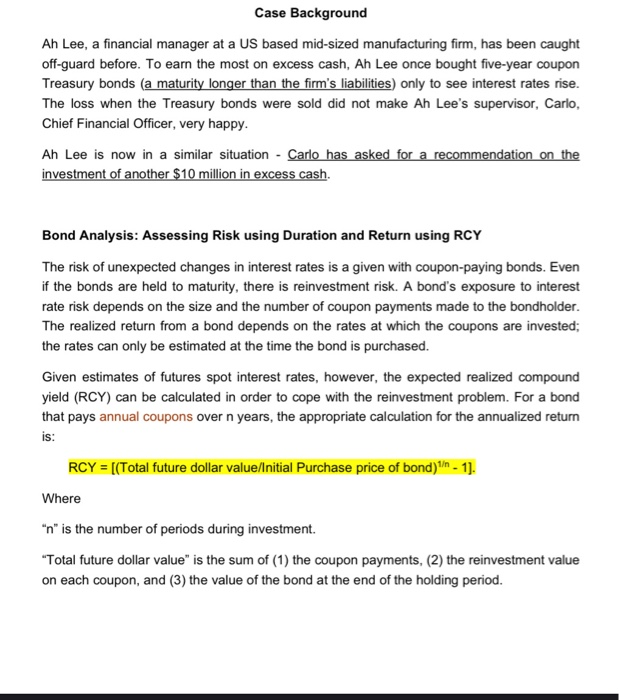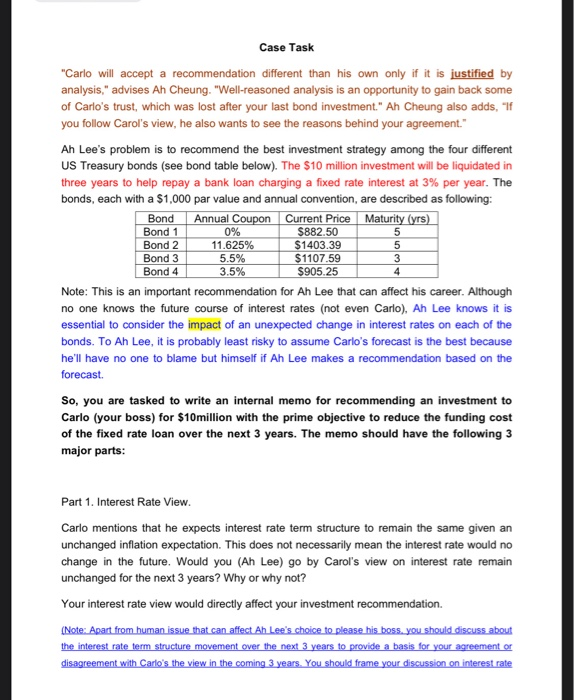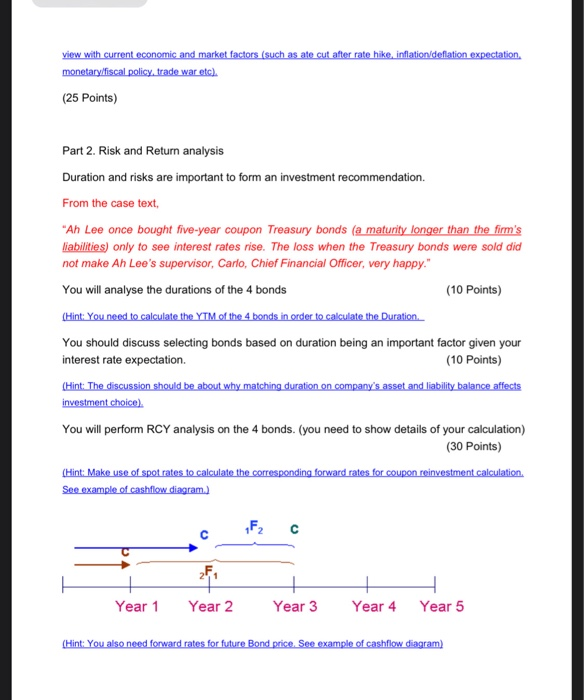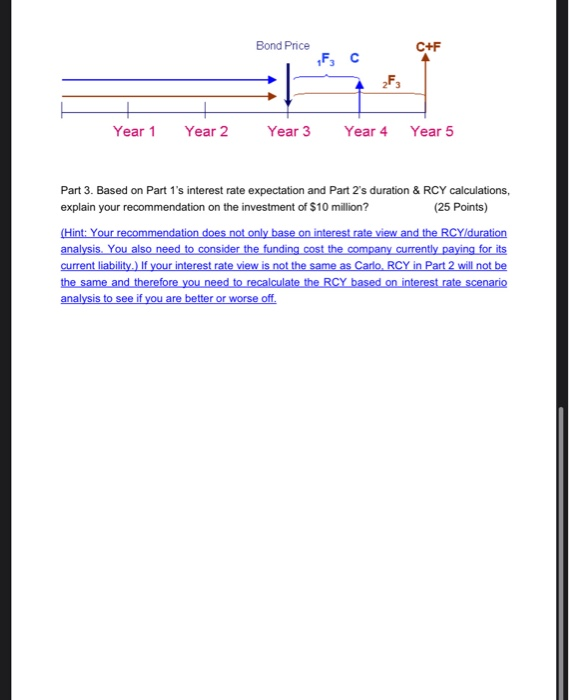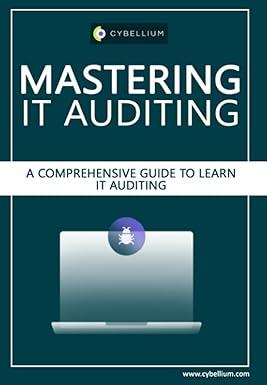Case Background Ah Lee, a financial manager at a US based mid-sized manufacturing firm, has been caught off-guard before. To earn the most on excess cash, Ah Lee once bought five-year coupon Treasury bonds (a maturity longer than the firm's liabilities) only to see interest rates rise. The loss when the Treasury bonds were sold did not make Ah Lee's supervisor, Carlo, Chief Financial Officer, very happy. Ah Lee is now in a similar situation - Carlo has asked for a recommendation on the investment of another $10 million in excess cash. Bond Analysis: Assessing Risk using Duration and Return using RCY The risk of unexpected changes in interest rates is a given with coupon-paying bonds. Even if the bonds are held to maturity, there is reinvestment risk. A bond's exposure to interest rate risk depends on the size and the number of coupon payments made to the bondholder. The realized return from a bond depends on the rates at which the coupons are invested; the rates can only be estimated at the time the bond is purchased. Given estimates of futures spot interest rates, however, the expected realized compound yield (RCY) can be calculated in order to cope with the reinvestment problem. For a bond that pays annual coupons over n years, the appropriate calculation for the annualized return is: RCY = [(Total future dollar value/Initial Purchase price of bond) In - 1). Where "n" is the number of periods during investment "Total future dollar value" is the sum of (1) the coupon payments, (2) the reinvestment value on each coupon, and (3) the value of the bond at the end of the holding period. In estimating the future dollars from a bond investment, Ah Lee needs a forecast of the direction and level of future interest rates in order to calculate the RCY. At yesterday's investment meeting, Carlo stated his view that interest rates would remain unchanged for the next three years because of an unchanging expected inflation rate and the economy environment will be stabilized. An Cheung, another financial manager at the firm and someone that has earned Carlo's respect for his reasoned judgment, suggests to Ah Lee to use the current term structure to form a basis for bond analysis and evaluate how interest rate expectations will change the analysis. Ah Cheung recommends the following table from Federal Reserve Statistical Release H.15 to get current spot rates on one-, two-, three-and four-year constant maturity Treasury securities. (See table below). Treasury constant maturities 1-month 3-month Spot Rate Today 1.58% 1.57% 1.58% 6-month 1-year 1.54% 2-year 1.61% 3-year 1.61% 4-year 1.63% 5-year 1.65% 1.75% 1.84% 7-year 10-year 20-year 30-year 2.16% 2.31% 5 5 Bond 2 Case Task "Carlo will accept a recommendation different than his own only if it is justified by analysis," advises Ah Cheung. "Well-reasoned analysis is an opportunity to gain back some of Carlo's trust, which was lost after your last bond investment." Ah Cheung also adds, "If you follow Carol's view, he also wants to see the reasons behind your agreement." Ah Lee's problem is to recommend the best investment strategy among the four different US Treasury bonds (see bond table below). The $10 million investment will be liquidated in three years to help repay a bank loan charging a fixed rate interest at 3% per year. The bonds, each with a $1,000 par value and annual convention, are described as following: Bond Annual Coupon Current Price Maturity (yrs) Bond 1 0% $882.50 11.625% $1403.39 Bond 3 5.5% $1107.59 3 Bond 4 3.5% $905.25 Note: This is an important recommendation for Ah Lee that can affect his career. Although no one knows the future course of interest rates (not even Carlo), Ah Lee knows it is essential to consider the impact of an unexpected change in interest rates on each of the bonds. To Ah Lee, it is probably least risky to assume Carlo's forecast is the best because he'll have no one to blame but himself if Ah Lee makes a recommendation based on the forecast So, you are tasked to write an internal memo for recommending an investment to Carlo (your boss) for $10million with the prime objective to reduce the funding cost of the fixed rate loan over the next 3 years. The memo should have the following 3 major parts: 4 Part 1. Interest Rate View. Carlo mentions that he expects interest rate term structure to remain the same given an unchanged inflation expectation. This does not necessarily mean the interest rate would no change in the future. Would you (Ah Lee) go by Carol's view on interest rate remain unchanged for the next 3 years? Why or why not? Your interest rate view would directly affect your investment recommendation. (Note: Apart from human issue that can affect An Lee's choice to please his boss, you should discuss about the interest rate term structure movement over the next 3 years to provide a basis for your agreement or disagreement with Carlo's the view in the coming 3 years. You should frame your discussion on interest rate view with current economic and market factors (such as ate cut after rate hike, inflation/deflation expectation monetary fiscal policy, trade war etc). (25 Points) Part 2. Risk and Return analysis Duration and risks are important to form an investment recommendation. From the case text, "Ah Lee once bought five-year coupon Treasury bonds (a maturity longer than the firm's liabilities) only to see interest rates rise. The loss when the Treasury bonds were sold did not make Ah Lee's supervisor, Carlo, Chief Financial Officer, very happy." You will analyse the durations of the 4 bonds (10 Points) (Hint: You need to calculate the YTM of the 4 bonds in order to calculate the Duration You should discuss selecting bonds based on duration being an important factor given your interest rate expectation. (10 Points) (Hint: The discussion should be about why matching duration on company's asset and liability balance affects investment choice) You will perform RCY analysis on the 4 bonds. (you need to show details of your calculation) (30 Points) (Hint: Make use of spot rates to calculate the corresponding forward rates for coupon reinvestment calculation. See example of cashflow diagram.) F2 21 + Year 1 Year 2 Year 3 Year 4 Year 5 (Hint: You also need forward rates for future Bond price. See example of cashflow diagram) Bond Price C+F F3 Year 1 Year 2 Year 3 Year 4 Year 5 Part 3. Based on Part 1's interest rate expectation and Part 2's duration & RCY calculations, explain your recommendation on the investment of $10 million? (25 Points) (Hint: Your recommendation does not only base on interest rate view and the RCY duration analysis. You also need to consider the funding cost the company currently paying for its current liability.) If your interest rate view is not the same as Carlo. RCY in Part 2 will not be the same and therefore you need to recalculate the RCY based on interest rate scenario analysis to see if you are better or worse off. Case Background Ah Lee, a financial manager at a US based mid-sized manufacturing firm, has been caught off-guard before. To earn the most on excess cash, Ah Lee once bought five-year coupon Treasury bonds (a maturity longer than the firm's liabilities) only to see interest rates rise. The loss when the Treasury bonds were sold did not make Ah Lee's supervisor, Carlo, Chief Financial Officer, very happy. Ah Lee is now in a similar situation - Carlo has asked for a recommendation on the investment of another $10 million in excess cash. Bond Analysis: Assessing Risk using Duration and Return using RCY The risk of unexpected changes in interest rates is a given with coupon-paying bonds. Even if the bonds are held to maturity, there is reinvestment risk. A bond's exposure to interest rate risk depends on the size and the number of coupon payments made to the bondholder. The realized return from a bond depends on the rates at which the coupons are invested; the rates can only be estimated at the time the bond is purchased. Given estimates of futures spot interest rates, however, the expected realized compound yield (RCY) can be calculated in order to cope with the reinvestment problem. For a bond that pays annual coupons over n years, the appropriate calculation for the annualized return is: RCY = [(Total future dollar value/Initial Purchase price of bond) In - 1). Where "n" is the number of periods during investment "Total future dollar value" is the sum of (1) the coupon payments, (2) the reinvestment value on each coupon, and (3) the value of the bond at the end of the holding period. In estimating the future dollars from a bond investment, Ah Lee needs a forecast of the direction and level of future interest rates in order to calculate the RCY. At yesterday's investment meeting, Carlo stated his view that interest rates would remain unchanged for the next three years because of an unchanging expected inflation rate and the economy environment will be stabilized. An Cheung, another financial manager at the firm and someone that has earned Carlo's respect for his reasoned judgment, suggests to Ah Lee to use the current term structure to form a basis for bond analysis and evaluate how interest rate expectations will change the analysis. Ah Cheung recommends the following table from Federal Reserve Statistical Release H.15 to get current spot rates on one-, two-, three-and four-year constant maturity Treasury securities. (See table below). Treasury constant maturities 1-month 3-month Spot Rate Today 1.58% 1.57% 1.58% 6-month 1-year 1.54% 2-year 1.61% 3-year 1.61% 4-year 1.63% 5-year 1.65% 1.75% 1.84% 7-year 10-year 20-year 30-year 2.16% 2.31% 5 5 Bond 2 Case Task "Carlo will accept a recommendation different than his own only if it is justified by analysis," advises Ah Cheung. "Well-reasoned analysis is an opportunity to gain back some of Carlo's trust, which was lost after your last bond investment." Ah Cheung also adds, "If you follow Carol's view, he also wants to see the reasons behind your agreement." Ah Lee's problem is to recommend the best investment strategy among the four different US Treasury bonds (see bond table below). The $10 million investment will be liquidated in three years to help repay a bank loan charging a fixed rate interest at 3% per year. The bonds, each with a $1,000 par value and annual convention, are described as following: Bond Annual Coupon Current Price Maturity (yrs) Bond 1 0% $882.50 11.625% $1403.39 Bond 3 5.5% $1107.59 3 Bond 4 3.5% $905.25 Note: This is an important recommendation for Ah Lee that can affect his career. Although no one knows the future course of interest rates (not even Carlo), Ah Lee knows it is essential to consider the impact of an unexpected change in interest rates on each of the bonds. To Ah Lee, it is probably least risky to assume Carlo's forecast is the best because he'll have no one to blame but himself if Ah Lee makes a recommendation based on the forecast So, you are tasked to write an internal memo for recommending an investment to Carlo (your boss) for $10million with the prime objective to reduce the funding cost of the fixed rate loan over the next 3 years. The memo should have the following 3 major parts: 4 Part 1. Interest Rate View. Carlo mentions that he expects interest rate term structure to remain the same given an unchanged inflation expectation. This does not necessarily mean the interest rate would no change in the future. Would you (Ah Lee) go by Carol's view on interest rate remain unchanged for the next 3 years? Why or why not? Your interest rate view would directly affect your investment recommendation. (Note: Apart from human issue that can affect An Lee's choice to please his boss, you should discuss about the interest rate term structure movement over the next 3 years to provide a basis for your agreement or disagreement with Carlo's the view in the coming 3 years. You should frame your discussion on interest rate view with current economic and market factors (such as ate cut after rate hike, inflation/deflation expectation monetary fiscal policy, trade war etc). (25 Points) Part 2. Risk and Return analysis Duration and risks are important to form an investment recommendation. From the case text, "Ah Lee once bought five-year coupon Treasury bonds (a maturity longer than the firm's liabilities) only to see interest rates rise. The loss when the Treasury bonds were sold did not make Ah Lee's supervisor, Carlo, Chief Financial Officer, very happy." You will analyse the durations of the 4 bonds (10 Points) (Hint: You need to calculate the YTM of the 4 bonds in order to calculate the Duration You should discuss selecting bonds based on duration being an important factor given your interest rate expectation. (10 Points) (Hint: The discussion should be about why matching duration on company's asset and liability balance affects investment choice) You will perform RCY analysis on the 4 bonds. (you need to show details of your calculation) (30 Points) (Hint: Make use of spot rates to calculate the corresponding forward rates for coupon reinvestment calculation. See example of cashflow diagram.) F2 21 + Year 1 Year 2 Year 3 Year 4 Year 5 (Hint: You also need forward rates for future Bond price. See example of cashflow diagram) Bond Price C+F F3 Year 1 Year 2 Year 3 Year 4 Year 5 Part 3. Based on Part 1's interest rate expectation and Part 2's duration & RCY calculations, explain your recommendation on the investment of $10 million? (25 Points) (Hint: Your recommendation does not only base on interest rate view and the RCY duration analysis. You also need to consider the funding cost the company currently paying for its current liability.) If your interest rate view is not the same as Carlo. RCY in Part 2 will not be the same and therefore you need to recalculate the RCY based on interest rate scenario analysis to see if you are better or worse off
